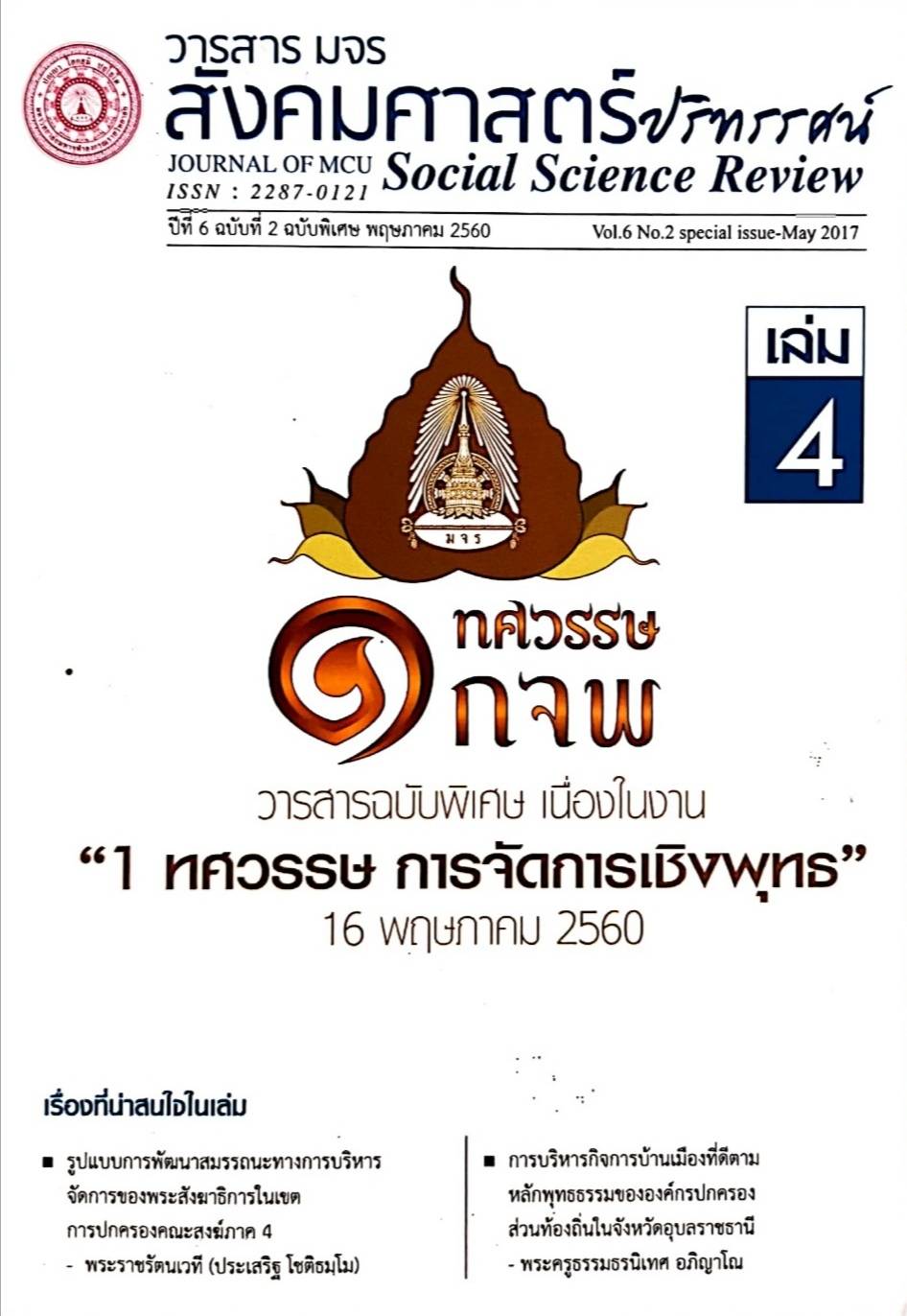รูปแบบการพัฒนาสมรรถนะทางการบริหารจัดการของพระสังฆาธิการ ในเขตการปกครองคณะสงฆ์ภาค 4
คำสำคัญ:
สมรรถนะ, รูปแบบการพัฒนาสมรรถนะ, การบริหารจัดการ, พระสังฆาธิการบทคัดย่อ
การวิจัยเรื่อง “รูปแบบการพัฒนาสมรรถนะทางการบริหารจัดการของพระสังฆาธิการใน
เขตการปกครองคณะสงฆ์ภาค 4” เป็นการศึกษาวิเคราะห์เพื่อพัฒนาสมรรถนะทางการบริหารจัดการของ
พระสังฆาธิการในเขตการปกครองคณะสงฆ์ภาค 4 ให้เกิดผลยิ่งขึ้น โดยมีวัตถุประสงค์คือ 1) เพื่อศึกษา
สมรรถนะทางการบริหารจัดการของพระสังฆาธิการในเขตการปกครองคณะสงฆ์ภาค 4 2) เพื่อ
ศึกษาวิเคราะห์การพัฒนาสมรรถนะทางการบริหารจัดการของพระสังฆาธิการเชิงพุทธบูรณาการ
และตามกรอบแนวคิดทฤษฎีที่เกี่ยวข้อง และ 3) เพื่อสร้างรูปแบบการพัฒนาสมรรถนะการบริหาร
จัดการของพระสังฆาธิการในเขตการปกครองคณะสงฆ์ภาค 4
การวิจัยในครั้งนี้ใช้ระเบียบวิธีวิจัยแบบผสานวิธี (Mixed Method Research) ระหว่าง
การวิจัยเชิงคุณภาพ (Qualitative Research) โดยการเก็บข้อมูลจากการสัมภาษณ์เชิงลึก (Indepth
Interview) จากผู้ให้ข้อมูลสาคัญ (Key Informants) ซึ่งเป็นพระสังฆาธิการผู้ปกครอง
ผู้ทรงคุณวุฒิรวมถึงผู้แทนจากหน่วยงานที่เกี่ยวข้อง จากนั้นนาข้อมูลและข้อเท็จจริงที่ได้เสนอต่อเวที
การสนทนากลุ่มเฉพาะ (Focus Group Discussions) เพื่อหาข้อสรุปที่เป็นแนวทางในการพัฒนา
สมรรถนะทางการบริหารจัดการของพระสังฆาธิการ ก่อนที่จะนาแนวทางที่ได้ไปสู่กระบวนการ
ทางการวิจัยเชิงปริมาณ (Quantitative Research) โดยใช้การศึกษาวิจัยเชิงสารวจ (Survey
Research) จากแบบสอบถาม (Questionnaire) เพื่อหาข้อสรุปที่มาจากค่าเฉลี่ยความคิดเห็นของ
พระสังฆาธิการผู้เป็นกลุ่มตัวอย่าง
ผลการวิจัย พบว่า
1. สมรรถนะทางการบริหารจัดการของพระสังฆาธิการในเขตการปกครองคณะสงฆ์ภาค
4 มีการบริหารจัดการตามกรอบสายงานการบังคับบัญชาและมุ่งเน้นการทางานเป็นทีม บนพื้นฐาน
การสารวมระวังทางกาย วาจา ใจ พร้อมยึดถือกฎ ระเบียบ และหลักพระธรรมวินัย มีความสมัคร
สมานสามัคคี ช่วยเหลือแบ่งปัน ไว้วางใจกัน ปฏิบัติต่อกันด้วยความเมตตา มีการปรึกษาหารือกัน
เป็นเนืองนิตย์เพื่อก่อให้เกิดสัมมาทิฐิและสัมมาสังกัปปะในการบริหารจัดการ
2. แนวทางในการพัฒนาสมรรถนะทางการบริหารจัดการของพระสังฆาธิการของพระ
สังฆาธิการในเขตการปกครองคณะสงฆ์ภาค 4 เชิงพุทธบูรณาการ ด้านกลยุทธ์ ควรมีการ
ประยุกต์ใช้หลักทุติยปาปณิกธรรมโดยเฉพาะด้านการพัฒนาให้เป็นผู้มีจักขุมาหรือมีวิสัยทัศน์ ด้าน
โครงสร้าง ควรมีการประยุกต์ใช้หลักอปริหานิยธรรมด้วยการเคารพหลักการที่ดีที่เคยวางเอาไว้แต่
เดิม ด้านระบบการปฏิบัติงาน ควรมีการประยุกต์ใช้หลักอิทธิบาทธรรมเพื่อนามาซึ่งความสาเร็จ
ด้านบุคลากร ควรมีการประยุกต์ใช้หลักสังคหวัตถุธรรมเพื่อการสงเคราะห์ช่วยเหลือซึ่งกันและกัน
ด้านทักษะ ควรมีการประยุกต์ใช้หลักภาวนา 4 ที่จะต้องพัฒนาทั้งทางกาย ศีล จิต และปัญญาอยู่
เสมอ ด้านรูปแบบทางการบริหารจัดการ ควรมีการประยุกต์ใช้ใช้หลักอปริหานิยธรรมด้วยการยึด
มั่นในความสามัคคี ความพร้อมเพรียง ทาพร้อมกัน เลิกพร้อมกัน และ ด้านค่านิยมร่วม ควรมีการ
ประยุกต์ใช้หลักสาราณียธรรมหรือหลักแห่งสามัคคีธรรมที่จะต้องปฏิบัติต่อกันด้วยเมตตาธรรม
3. รูปแบบการพัฒนาสมรรถนะทางการบริหารจัดการของพระสังฆาธิการในเขตการ
ปกครองคณะสงฆ์ภาค 4 ด้านกลยุทธ์ สิ่งที่สาคัญที่พระสังฆาธิการจะพัฒนาการบริหารจัดการเพื่อ
ก่อให้เกิดประสิทธิภาพและประสิทธิผล คือ 1) จะต้องยึดถือกรอบการบริหารจัดการและการ
ประพฤติปฏิบัติให้เป็นไปตามหลักธรรมวินัย 2) จะต้องมีการวางยุทธศาสตร์ กลยุทธ์ และพันธกิจใน
บริหารจัดการ และ 3) จะต้องมีตัวชี้วัดความสาเร็จที่มีมาตรฐาน ด้านโครงสร้าง 1) จะต้องบริหาร
จัดการแบบมีส่วนร่วม 2) หากบริหารจัดการตามแนวดิ่งก็ขอให้ลดระเบียบ ขั้นตอนให้สั้นลง และ 3)
บริหารจัดการแบบผสมผสานตามความเหมาะสมของปัญหาและสถานการณ์ ด้านระบบการ
ปฏิบัติงาน 1) ปฏิบัติหน้าที่โดยยึดผลประโยชน์ของส่วนรวมมากกว่าส่วนตัว 2) ปฏิบัติหน้าที่ด้วย
ความสารวมระวังทั้งทางกาย วาจา ใจ และ 3) ปฏิบัติหน้าที่ตามหลักธรรมาภิบาล มีความโปร่งใส
ตรวจสอบได้ ด้านบุคลากร 1) บริหารจัดการงานด้วยหลักสราณียธรรมหรือด้วยความรัก ความ
เมตตา 2) บริหารจัดการด้วยหลักอปริหานิยธรรมหรือหลักความสมัครสมานสามัคคี และ 3) บริหาร
จัดการด้วยหลักสังคหวัตถุหรือหลักการเผื่อแผ่แบ่งปัน ช่วยเหลือเจือจุล ด้านทักษะ 1) พัฒนาทักษะ
ทางการสื่อสารการประชาสัมพันธ์ 2) พัฒนาทักษะในการสร้างทีมและการทางานระบบทีม และ 3)
พัฒนาทักษะความเชี่ยวชาญเฉพาะตนเพื่อความเป็นเลิศ ด้านรูปแบบการบริหารจัดการ 1) บริหาร
จัดการงานบนพื้นฐานของหลักอปริหานิยธรรม 2) การบริหารจัดการบนพื้นฐานหลักสราณียธรรม
3) บริหารจัดการตามหลักพระธรรมวินัย ด้านค่านิยมร่วม 1) บริหารจัดการบนพื้นฐานของหลักอป
ริหานิยธรรม 2) บริหารจัดการบนพื้นฐานของหลักพรหมวิหารธรรม 3) การบริหารจัดการบน
พื้นฐานหลักสัมมาทิฏฐิ
เอกสารอ้างอิง
ศาสตรมหาบัณฑิต. บัณฑิตวิทยาลัย : มหาวิทยาลัยมหาจุฬาลงกรณราชวิทยาลัย.
โชติ บดีรัฐ. (2554). “การบริหารงานของพระสังฆาธิการ ในเขตการปกครองคณะสงฆ์ภาค 4 เพื่อ
ความมั่นคงแห่งพระพุทธศาสนา”. วิทยานิพนธ์รัฐประศาสนศาสตรดุษฎีบัณฑิต. บัณฑิต
วิทยาลัย: มหาวิทยาลัยราชภัฏวไลยอลงกรณ์.
ดาระกา ศิริสันติสัมฤทธิ์. (2552). “การศึกษารูปแบบสมรรถนะของบุคลากรสายสนับสนุนวิชาการ
ในสถาบันอุดมศึกษาภาครัฐ”. รายงานวิจัย. คณะครุศาสตรอุตสาหกรรม : สถาบัน
เทคโนโลยีพระจอมเกล้าเจาคุณทหารลาดกระบัง.
พระครูวชิรคุณพิพัฒน (เอนก คุณวุฑฺโฒ). (2558). “การพัฒนาภาวะผูนาของพระสังฆาธิการในเขต
ปกครองคณะสงฆภาค 4”. วิทยานิพนธ์พุทธศาสตรดุษฎีบัณฑิต (รัฐประศาสนศาสตร).
บัณฑิตวิทยาลัย : มหาวิทยาลัยมหาจุฬาลงกรณราชวิทยาลัย.
พระทีฆทัสสีมุนีวงศ์ (วิรัช วสสิริ). (2557). “ตัวแบบการบริหารคณะสงฆ์ในเขตปกครองคณะสงฆ์
ภาค 4”. วิทยานิพนธ์รัฐประศาสนศาสตรดุษฎีบัณฑิต. บัณฑิตวิทยาลัย : มหาวิทยาลัย
ราชภัฏวไลยอลงกรณ์ ในพระบรมราชูปถัมภ์.
สาธิต พนารี. (2557). “กระบวนทัศนใหมการบริหารจัดการวัดในยุคโลกาภิวัตน์”. วิทยานิพนธ์
รัฐประศาสนศาสตรดุษฎีบัณฑิต. บัณฑิตวิทยาลัย : มหาวิทยาลัยราชภัฏวไลยอลงกรณ
ในพระบรมราชูปถัมภ.
สานักงานเจ้าคณะจังหวัดนครสวรรค์. (2559). การคณะสงฆ์จังหวัดนครสวรรค์ ภาค 4 รายงานผล
การปฏิบัติงาน 2559. นครสวรรค์ : สานักงานเจ้าคณะจังหวัดนครสวรรค์ (กลาง) พุทธ
อุทยานนครสวรรค์.
สานักงานรองเจ้าคณะจังหวัดนครสวรรค์ (ฝ่ายเผยแผ่และสาธารณูปการ). (2559). แผนยุทธศาสตร์
การพัฒนาหน่วยอบรมประชาชนประจาตาบล (อ.ป.ต.) ระยะที่ 1 (พ.ศ. 2559-2563)
ของคณะสงฆ์จังหวัดนครสวรรค์. นครสวรรค์ : วัดวรนารถบรรพต พระอารามหลวง.
ดาวน์โหลด
เผยแพร่แล้ว
รูปแบบการอ้างอิง
ฉบับ
ประเภทบทความ
สัญญาอนุญาต
ลิขสิทธิ์ (c) 2020 วารสาร มจร สังคมศาสตร์ปริทรรศน์

อนุญาตภายใต้เงื่อนไข Creative Commons Attribution-NonCommercial-NoDerivatives 4.0 International License.
เพื่อให้เป็นไปตามกฎหมายลิขสิทธิ์ ผู้นิพนธ์ทุกท่านต้องลงลายมือชื่อในแบบฟอร์มใบมอบลิขสิทธิ์บทความให้แก่วารสารฯ พร้อมกับบทความต้นฉบับที่ได้แก้ไขครั้งสุดท้าย นอกจากนี้ ผู้นิพนธ์ทุกท่านต้องยืนยันว่าบทความต้นฉบับที่ส่งมาตีพิมพ์นั้น ได้ส่งมาตีพิมพ์เฉพาะในวารสาร มจร สังคมศาสตร์ปริทรรศน์ เพียงแห่งเดียวเท่านั้น หากมีการใช้ภาพหรือตารางหรือเนื้อหาอื่นๆ ของผู้นิพนธ์อื่นที่ปรากฏในสิ่งตีพิมพ์อื่นมาแล้ว ผู้นิพนธ์ต้องขออนุญาตเจ้าของลิขสิทธิ์ก่อน พร้อมทั้งแสดงหนังสือที่ได้รับการยินยอมต่อบรรณาธิการ ก่อนที่บทความจะได้รับการตีพิมพ์ หากไม่เป็นไปตามข้อกำหนดเบื้องต้น ทางวารสารจะถอดบทความของท่านออกโดยไม่มีข้อยกเว้นใดๆ ทั้งสิ้น





